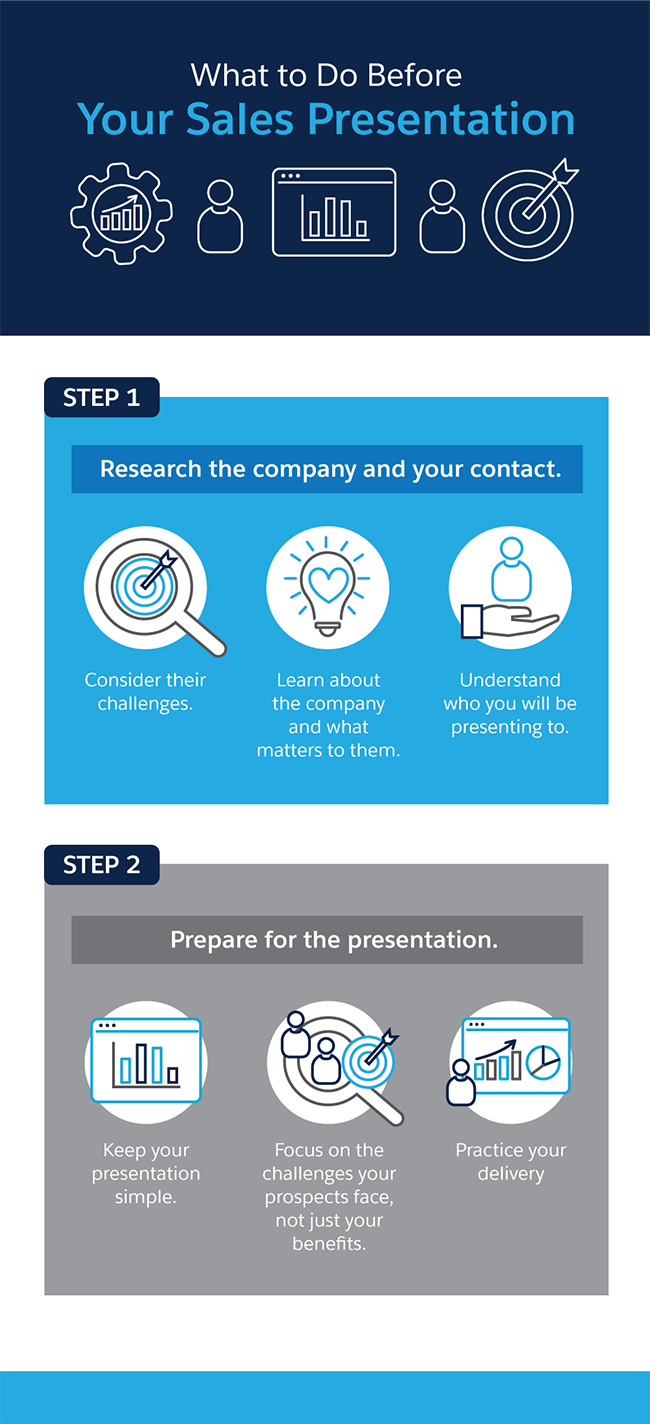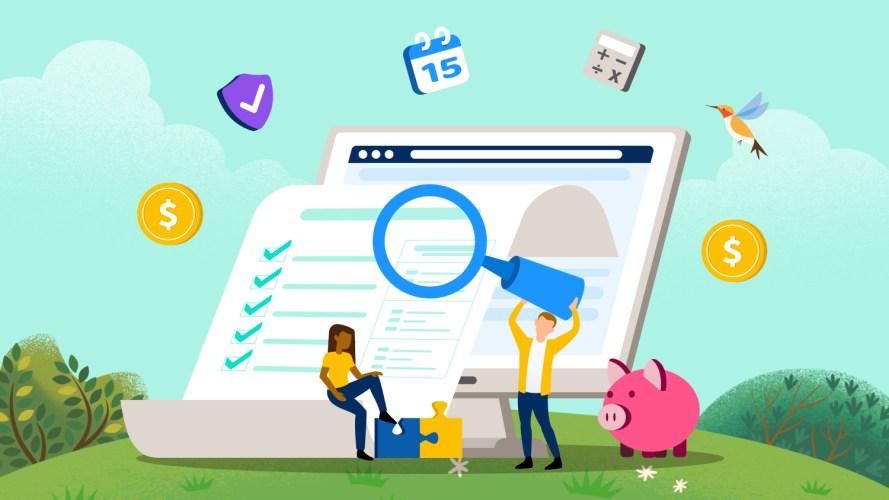When it comes to building an effective sales presentation, no one-size-fits-all sales deck exists.
Every sales presentation you deliver to a prospect should be personalized and tailored just for them. Successful selling today is about establishing yourself as a trusted advisor. Cookie-cutter messages won’t do that. So how should you get started?
High-performing sellers close more deals by focusing on their prospects, rather than their products. Follow these sales presentation tips before, during, and after your next meeting to make it more resonant (and hopefully, more lucrative). These tips work whether you’re building customer relationships remotely or in person.
Deliver polished presentations that address your prospect’s biggest pain points
Use generative AI, powered by Einstein, to help you draft an engaging, tailored talk track for your next sales presentation, perfectly aligning product value to specific prospect needs.




Step 1: Research the company and your contact
An effective sales presentation starts long before the actual presentation. The first step is to learn who your prospect is and the challenges they face; then you can use those insights to show how you can help them succeed.
In particular, you should research the company, the challenges it faces, and the contacts who will hear your presentation.
Learn more about the company’s past, present, and future
First, consult your CRM platform. Find other accounts from the prospect’s industry and see what their customer journeys looked like. Their client information and case history will help you learn what products and services they use most and how your company serves them well. The information in your CRM platform can give you insights and tips that will help you win deals like the one you’re currently working on. Take a look, too, at the sales pipeline for that particular industry. Your CRM system is a tool specifically used to help you sell successfully and should be used throughout the sales process.
Once you have that preliminary information, head to the company website and research what the prospect’s company does, how big it is, and what products or services it offers. Then, dig deeper. Make a note of their mission, values, and corporate culture. Also try to learn more about the company’s history and any news items involving the company. Look into the company’s annual report to get a good idea of where it might be headed in the future.
Your presentation should focus on using insights from your research to show a deep understanding of the company and why your product or service can help it grow.
Consider the company’s challenges
As you learn about the company, pay special attention to the challenges it faces that are relevant to your product or service offerings. Remember these issues so you can use them as conversation starters during your sales presentation. Then you can offer advice — or insights — about how they could better face those challenges.
This type of approach is called insight selling: You as a salesperson bring unique, tailored insights to a prospect to solve their problems.
For example, if you sell a marketing tool, you may notice in your research that your lead is currently using the same ads across social media, search, and display networks. Your insight might be, “I see that your company is using the same ad copy across several platforms. How have those ads been performing for you? Have you been able to reach your sales or traffic goals?” Their answer may change aspects of your sales presentation or may make it even stronger.
Learn more about your audience
When it comes to communication, knowing who will be in the room is critical. If your prospect is the Director of Production, your most effective sales presentation may focus on metrics that can determine how to improve output. If your prospect will be presenting the information to a decision maker, offer resources to help make it easier for them.
Step 2: Prepare for your sales presentation
After gathering insights about the company and your contacts, you are ready to put together your presentation. Whether you use a sales presentation template that your workplace provides or you start from scratch, use these sales presentation tips to build a more compelling pitch.
Focus on the challenges your prospects face, not just your benefits
Salespeople should present themselves as a trusted advisor, not just a company representative. Look for ways to create a dialogue with the prospect and share how you can help their company work more efficiently, provide better service, or solve the challenges holding them back.
Keep your presentation simple
Sales template decks can be useful, but they can also overwhelm prospects if they’re too long. Instead of a 50-slide canned presentation, focus on keeping the slide deck relatively simple and highlighting engaging images and key statistics. This will make it easier to use a storytelling approach, rather than just reading off a slide.
Practice your presentation
You want to prepare, but you don’t want to come across as robotic or scripted. Practice what you’ll say and how you’ll answer questions, and make sure you’ve memorized important statistics or metrics. Build time into the presentation so you can share personal anecdotes or pause for questions.
Keep your delivery style confident, but agile. You may find that one point you thought would be critical doesn’t have as much impact with your prospect as you’d hoped, but a different point unexpectedly piques their interest. Keeping your talk track fluid will make it easier to shift gears if you need to.
Step 3: Nail your sales presentation
Presentation day has arrived. You’ve done your research, nailed the perfect storytelling approach, and trimmed down your slide deck. Now is your time to shine. Here are a few sales presentation tips to help your pitch end in a sale.
End the meeting with your presentation; don’t begin with it
You’ve likely had conversations with your contact and know them well enough, but in this presentation you’ll potentially meet additional people who make decisions. Take the time to get to know each attendee.
Building a rapport with your audience before pitching is a no-brainer. But avoid too much small talk; it can come across as inauthentic or like a waste of the customer’s time. Instead, time permitting, try to use the beginning of the meeting asking questions about day-to-day operations and goals. Ask specific questions that demonstrate your knowledge of their company and industry, and use the answers to shape your narrative. Then, during your presentation, tie back to topics the prospect brought up and focus on how you, the trusted advisor, can help.
Ask questions during the presentation to encourage a dialogue
Getting feedback from your prospect during the actual presentation is the best sales presentation technique of all. This allows you to change your focus in the moment, rather than spending your presentation talking about challenges and solutions that might be unimportant to your prospect.
After you make a key point, ask your prospect a question like, “Does this make sense in your industry?” or “Can you see this applying to your company?” This prompts the prospect to either agree or start a dialogue about pain points and how your products and services can better serve them.
If they agree with you, then you know you’re on the right track and that your suggestions are up to date. On the other hand, if they have clarifications, this lets you adjust your presentation — and follow-up efforts — to better fit their position.
Include proof that shows how your products and services have helped others
Every sales presentation should include research data and customer stories. To be even more effective, however, put names and faces to that proof by adding pictures and testimonials to your slide deck. Pictures help increase credibility and can provide the social proof your prospect needs to overcome barriers to closing.
Step 4: Prioritize the follow-up just as much as the presentation
The actual sales presentation is just one part of your sales process, and it doesn’t guarantee a signed contract or even further contact with you. The final piece of your sales presentation is a well-planned follow-up, and it’s just as important as the presentation itself.
The most effective follow-up format will depend on your prospect, their needs, and how they best retain information. For example, you may follow up by:
- Emailing your slide deck and asking to schedule a follow-up call. Just remember to avoid the “Just following up” email and make sure your email offers the recipient value.
- Scheduling follow-up emails to reiterate key points in your presentation. A sales automation tool automates emails to share product information and set reminders for you to connect. It helps make sure no prospects fall through the cracks.
- Preparing personalized content that highlights the main points from your sales presentation and includes videos of products in action, testimonials, or other helpful collateral.
- Sending an additional resource about a topic they mentioned during your meeting, whether it pertained to your presentation or not.
Your sales presentation doesn’t end when you walk out the door or end the meeting. As you research and present your pitch, consider what the best follow-up approach will be. Then, take the time to create a well-considered follow-up strategy.
You can make your next sales presentation your best
Preparation and practice are key to successful sales presentations. But there’s so much more to a great presentation than well-designed slides or new research. The heart of a great sales presentation is the relationship between you and your customer, and that’s built on unique insights focused on your potential customer’s challenges and needs.
When you focus on helping, rather than pitching, your sales presentation is more likely to be a hit. That’s a win-win for you and your customer.

























